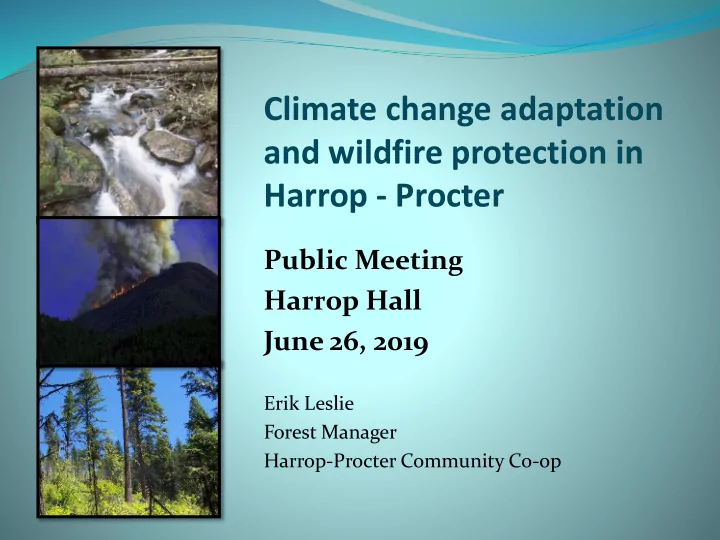

Climate change adaptation and wildfire protection in Harrop - Procter Public Meeting Harrop Hall June 26, 2019 Erik Leslie Forest Manager Harrop-Procter Community Co-op
Climate models: simplified summary Over the next 30 to 50 years: Fall/ winter/ spring 2 - 5 warmer and 10 - 25% wetter Summers 3 - 7 warmer and up to 30% drier ~5 to 10+ times more average annual area burned Increased frequency and magnitude of extreme precipitation events 2
Harrop-Procter community priorities Relatively consistent community values for 20 years Protect domestic water Maintain/ enhance biodiversity Create local jobs Community wildfire protection (new priority since 2003) 3
Overview of project workplan 1. Risk assessment 2. Operations strategy 3. Management Plan and AAC 4
etc 5
Risk Assessment Objective: Prioritize areas for adaptive actions • Focus on next 20 to 40 years RISK = Probability X Consequence Probability of: Consequence to: Fire Homes Fire Consequence Drought Water High Moderate Low Very_low High Biodiversity Probability Moderate Fire Timber Low Very Low Fire Risk High Moderate Low 6
Fire probability Fire probability = likelihood of high severity fire High probability Moderate probability Low probability High fuel loads (from LiDAR) Moderate fuel loads Low fuel loads Dry site (per aSMR) Moderate site (per aSMR) Moist site (per aSMR) High percentage dead pine Slopes >50% Slopes 30 – 50% Slopes <30% 7
8
9
Fuel density 10
11
Absolute Soil Moisture 12
13
14
Consequence mapping Homes Water Biodiversity Timber 17
18
19
20
Risk Fire Consequence High Moderate Low Very_low High Probability Moderate Fire Low Very Low Fire Risk High Moderate Low
Fire risk to water — coming
Add climate change Average CMD ensemble all decades and scenarios ID2 Scenario Average of CMD ICH xw rcp45 433 Average CMD ensemble by subzone ICH xw rcp85 462 ICH dw 1 rcp45 302 500 ICH dw 1 rcp85 330 450 ICH mw 4 rcp45 169 400 ICH mw 4 rcp85 196 350 ESSFwh 3 rcp45 113 300 ESSFwh 3 rcp85 136 250 ESSFwm 4 rcp45 75 200 ESSFwm 4 rcp85 92 150 ESSFwm 3 rcp45 69 100 ESSFwm 3 rcp85 88 50 ESSFwmw rcp45 50 0 ESSFwmw rcp85 67 rcp45 rcp85 rcp45 rcp85 rcp45 rcp85 rcp45 rcp85 rcp45 rcp85 rcp45 rcp85 ESSFwmp rcp45 36 ICH xw ICH dw 1 ICH mw 4 ESSFwh 3 ESSFwm 4 ESSFwm 3 ESSFwmp rcp85 51 25
26
2080’s drought probability 27
2080’s fire probability 28
2080’s fire risk to homes? 29
Risk assessment conclusions Top priority areas for adaption actions : Homes : Entire WUI (that is not wet or thinned) Timber : All accessible stands on submesic sites Water : Headwaters areas with high fuel loads Biodiversity : Older forests on submesic (mesic) sites Examples of target areas: dense submesic ICH stands, especially with cedar Any feasible landscape-level fuel break
Operations strategy — based on risks Reserve design Landscape fire breaks WUI fuel reduction Prescribed fire Residual stand structure Stocking standards Stand tending Species and provenances More adaptation tools? Manage for resilience 32
60 - 70% of landbase in reserves 33
Fire/ fuel hazard reduction 34
35
37
38
Interface areas 40
41
42
43
44
45
Resilience 46
47
48
49
50
51
52
53
54
Plant Ponderosa pine and deciduous species 55
Management Plan and AAC: Community decisions 56
Next steps 2019 Document operations strategy, develop AAC scenarios Project newsletter #2 summer — send to stakeholders Draft Handbook and Workshop — circulate to advisory committee Advisory committee meeting #4: ~October/ November Public meeting in Harrop ~November Practitioners’ workshop ~December 57
End of presentation 58
Recommend
More recommend